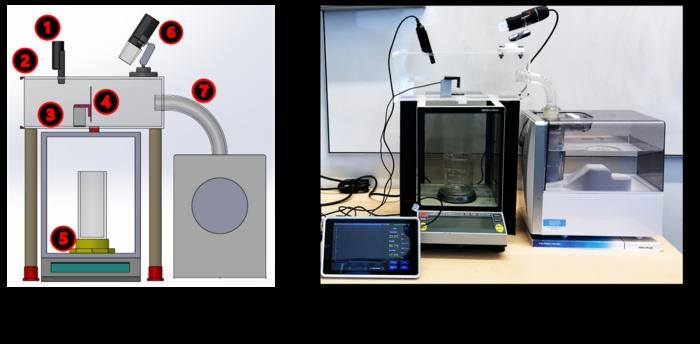A group of scientists is developing novel systems to capture water vapor in the air and convert it to liquid.
 Fog harvesting-setup. Image Credit: University of Waterloo
Fog harvesting-setup. Image Credit: University of Waterloo
Michael Tam, a Professor at the University of Waterloo, and his Ph.D. Students Yi Wang and Weinan Zhao have created sponges or membranes with a large surface area that continuously capture moisture from their surroundings.
Fresh water for human consumption has conventionally been obtained from rivers, lakes, groundwater, and oceans (with treatment). Dr. Tam’s current technologies are inspired by nature and are designed to harvest water from alternative sources as the world faces a serious freshwater scarcity.
A spider’s web is an engineering marvel. Water is efficiently captured by the web. The spider doesn’t need to go to the river to drink, as it traps moisture from the air.
Michael Tam, Professor and University Research Chair, Functional Colloids and Sustainable Nanomaterials, University of Waterloo
Namib desert beetles, which lack easy access to water, obtain water by leaning into the wind and catching fog droplets with their textured body armor. This makes it possible for the moisture to gather and drip into their mouths.
Tam and his research team are utilizing biomimetic surface engineering to harvest water sustainably. Atmospheric water harvesting is one of the technologies Tam is developing. Tam’s research team is developing a comparable surface structure to the beetle’s special surface structure using a cellulose-stabilized wax emulsion to create surfaces that draw small water droplets while quickly releasing larger ones.
Tam is developing sustainable technologies using net zero carbon materials like natural and plant-based materials. Using the power of interfacial science and nanotechnology, his research team is developing technologies that capture and repel water droplets. He was able to create superhydrophobic and waterproof paper. He is also developing a smart and tunable surface that captures and dehumidifies air with minimal energy consumption.
The next step is to create a scalable method for developing such surfaces.
Solar evaporation systems directly harvest solar energy by absorbing water and evaporating it to produce fresh collectible vapor. The smart biomimetic structural designs for solar evaporation were inspired by unique mushroom structures.
The suggested freshwater generation systems are low-cost, energy-efficient, and eco-friendly.
Journal Reference:
Wang, Y., et al. (2023). Biomimetic surface engineering for sustainable water harvesting systems. Nature Water. doi.org/10.1038/s44221-023-00109-1.